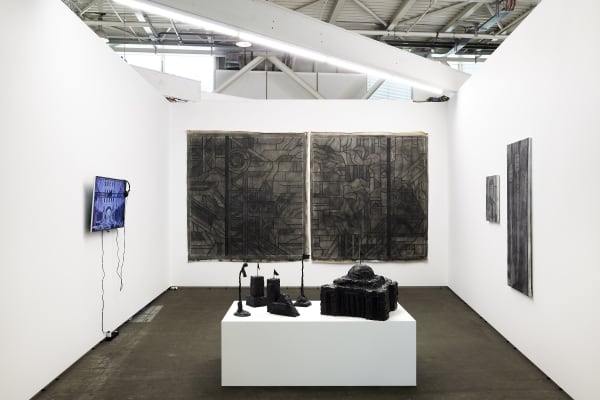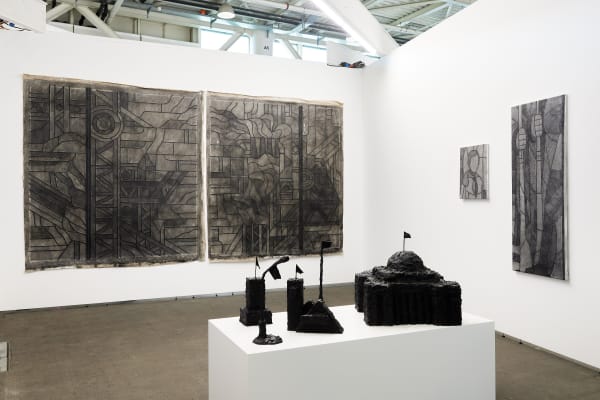Voloshyn Gallery presents a project by Mykola Ridnyi and Danylo Halkin at Liste Art Fair Basel.
Wars, social turmoil, and conflicts always cause massive destruction and spontaneous transformations, driving sweeping reassessment of everyday reality. The works by Mykola Ridnyi and Danylo Halkin included in this exhibition are completely different in their nature, but share the theme of capturing time through the prism of space and illusion of presence. The most apt approach to delve into this concept is Hans Ulrich Gumbrecht’s idea of “production of presence”, which denotes the effect of presence or of reality created by means of media. The philosopher argues that contemporary media technologies, such as TV, cinema, Internet, and VR are able to generate experiences of being in other places, times, or realities. He points out that the production of presence can have both positive and negative consequences, and must be critically examined in order to understand its impact on society.
In the series entitled Optical Prostheses, Danylo Halkin continues his exploration of Soviet decorative design. This time, he focuses on stained-glass windows of hospitals, conscription offices, and fire stations, creating a coherent artistic statement put in the wartime context. The paintings depict windows of actual buildings located in the Dnipropetrovsk region, smoked stained glass against the backdrop of smoky sky in the wake of another Russian attack. All of the windows are either damaged by missile strikes or splintered and shattered by dismantling in the course of decommunization project underway in Ukraine. The artist attaches to the canvases shards of the stained glass, thus giving it a new meaning, together with a status of a work of art, which it has never had before. In a way, the resulting pieces capture the spirit of today while allowing the viewer a peek into the atmosphere of original surroundings of the decorative windows.
The title Optical Prostheses refers to distortion of history, for instance, through the prism of Kremlin propaganda and Russian imperialism. The narratives of the stained-glass windows were propagandist tools all along, but the war has upended our perception of them, reversing the effect. Now, they showcase war crimes, sometimes quite literally visualizing news headlines from Ukraine.
Engaged in the dialogue with Danylo Halkin’s works is the series of sculptures by Mykola Ridnyi, entitled More Flags. In it, the artist reflects upon the notion of space, reproducing shapes of government buildings, marketplaces, apartment blocks, and vehicles. All of those share a common detail, namely the presence of a flag. This series was initially meant as an inquiry into the symbolic purpose of flags as ideological markers of territory. In times of war, a flag assumes ambivalent meanings ranging from a symbol of solidarity, national identification, and safety to that of occupation and direct threat. Seen from the military perspective, facilities marked with a flag are often potential targets. Black paint covering the sculptures erases any links to the original context of architecture and design, instead provoking associations with burned city landscapes. Forms shaped in a rough expressionist manner symbolize damages that Ukraine’s urban infrastructure suffered due to the Russian attacks.
The final part of this project is Mykola Ridnyi’s eloquent video Regular Places, made in 2014-2015 and recreated in the new context. In it, the artist explores the topic of neglected memory and emotional paralysis of an entire city caused by social and political upheaval. The original video was based on mass brawls between activists on Kharkiv streets, sudden bursts of violence in public spaces. This was very unusual for the city, which Ridnyi (who grew up there) has always seen as quiet and calm. At the time, he filmed peaceful scenes of everyday life in the areas where the clashes took place earlier, and combined the footage with sounds of the fights taken from YouTube videos. Responding to the original work, an art critic noted that in the case of Kharkiv, one could never be sure that the past would actually stay in the past. In 2022, the city experienced a new wave of violence, but this time much more extensive one, with military invasion and missile attacks. Ridnyi decided that after the breakout of the full-scale war, this work could not be displayed in its original version, as the context has changed drastically. Today, it would be seen as depicting some sort of a civil conflict, which is inappropriate in a country that defends itself against a brutal war of aggression. In May 2022, the artist visited Kharkiv to film the same places (now completely shattered) again. This time, there was no sound to be added; the new video shows ruins of the city and is completely silent.
Monday, June 12 - Sunday, June 18, 2023
Booth 78
For all press inquiries, please contact:
info@voloshyngallery.art




